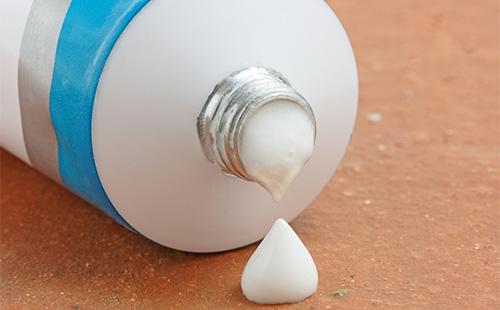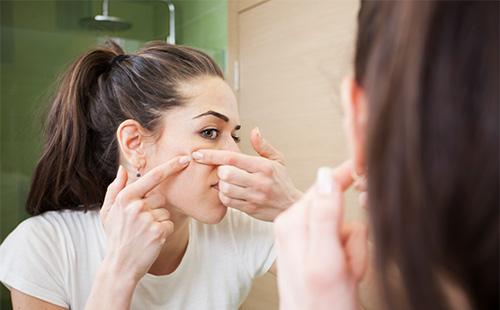The content of the article
The substance was first isolated from willow bark, after which scientists were able to synthesize a similar product. It turned out to be reactive. So discovered salicylates. The drug can not be used inside. It disrupts the nervous system, causes liver damage. But acetylsalicylic acid (a derivative of salicylic acid) turned out to be a safe antipyretic.
Release Forms
Salicylic acid is used for the manufacture of external preparations - the solution of the same name and ointment. The percentage of active substance may differ - the scope of use of the drug depends on this. So, drugs with a low concentration are used to treat skin diseases, and with a high one - to eliminate calluses and growths.
In addition to ointment and solution, salipod patch is sold in pharmacies. Its purpose is to soften corns and corns for their subsequent removal. The substance is also included in other drugs, combining with various pharmacologically active compounds: Galmanin, Diprosalik, Lorinden, Otinum (drops in the ears).
Indications for use
The drug is prescribed for a number of pathological processes in epidermal structures:
- penetration of bacteria and fungi - mycoses, erythrasma, streptoderma, infectious and inflammatory lesions;
- growths and education - ichthyosis, corns, warts, corns;
- dysfunctions of the epidermis - sweating, hyperkeratosis, increased activity of the sebaceous glands;
- other - eczema psoriasis, idiopathic dermatitis, acne, post-acne.
The properties
The drug acts destructively on fungal and bacterial cells - it provokes protein denaturation in the unicellular membrane. In combination with ethyl alcohol, the acid becomes a good antiseptic that can stop the development of pathological microorganisms on the skin.
Use with growths is justified by the keratolytic effect of the substance in high concentrations. It provides exfoliation of the keratinized layer of the epithelium. The same property allows you to enter salicylic acid in the composition of exfoliating masks, peels. The drug helps to eliminate:
- keratinized layer of the epithelium;
- hyperkeratosis in psoriasis and seborrhea;
- sebaceous plugs;
- closed comedones;
- post-acne;
- dark spots;
- fine wrinkles.
The substance is able to narrow pores, inactivate sweat and sebaceous glands. As a result, conditions for the development of pathogenic microflora are sharply worsened, as well as for clogging of pores with sebum and dirt. Focusing on such properties, dermatologists prescribe the drug to people with acne, oily and problem skin, with sweating.
Efficiency in rashes
The effect depends on the method of application of the drug and the nature of the rashes. With acne, the substance:
- eliminates fat content;
- softens sebaceous plugs;
- exfoliates the stratum corneum;
- cleanses pores;
- prevents inflammation;
- updates the epidermis.
Helps to eliminate spots left after acne: exfoliates, provides blood flow to the treatment sites and enhanced skin regeneration.
Reduces inflammation, increasing blood flow and inhibiting the production of certain mediators due to a locally irritating effect. Relieves pain and discomfort that traditionally accompany the formation of an abscess. If you treat the skin when inflammation is just beginning, you can prevent the occurrence of large acne.
The drug is used in various parts of the body. Peelings with it prevent the formation of pigmentation, eliminate ingrown hair, renew and rejuvenate the dermis.

Contraindications
Do not allow the medicine to get on the mucous membranes (this will cause a burn), treat the area of moles, the skin in the genital area with the product. Caution should be used by patients with dry and sensitive types of dermis -
the drug can cause irritation.
Side effects are manifested with long-term use of the drug, treatment of large areas of the skin with it. As can be seen from the table, they can be local or systemic (if the drug is absorbed through the skin into the systemic circulation or is used along with other salicylates).
Table - Side effects of the drug
| Local | System |
|---|---|
| - Itching; - redness; - dryness; - peeling; - contact dermatitis; - irritation; - allergic reactions | - Noise in ears; - dizziness; - stomach ache; - nausea; Vomiting - respiratory failure; - cramps; - acidosis |
Contraindications for using the drug in any form:
- sensitivity to salicylates;
- pregnancy;
- childhood;
- renal failure;
- liver failure.
You can not use acne medicine for a long time. The maximum duration of therapy is 20 days. It is preferable to take a break after each week of regular use.
Methods and rules for use
For cosmetic purposes, an alcohol solution is most often used. In addition to alcohol and the active substance itself, there is nothing more in the preparation. It is released without a prescription.
1% solution
For the treatment of the face, 1% is used. Increased concentrations lead to irritation. The rules of application are as follows.
- Training. Before processing, the face must be cleaned with a mild detergent. The use of exfoliating products is acceptable if they are non-abrasive. Waiting for the skin to dry completely.
- Application Salicylic alcohol is applied to a cotton pad or piece of cotton, gently rubbing all affected areas in one direction. It should be well moistened with acid in areas where there is a rash.
- Post-care. After 15 minutes (especially if the entire face was processed), you need to wash again, treat the skin with caring cosmetics.
In order for the solution to act and not provoke undesirable phenomena, it is important to remember that it is impossible:
- rub the product until a tingling sensation;
- before applying make rough peels;
- squeeze acne the day before.
2% solution and ointment
For spot treatment, a 2% solution is acceptable: with a cotton swab, the agent is applied to single comedones and inflammations. The rules are the same: the skin is first cleaned, and after the procedure, the acid is washed off.
Ointments are used in the same way - they directly treat the places of inflammation, acne, ulcers. But she is left for several hours. In some cases, even at night, and in the morning they are removed with a scrub.
Talkers
In some situations, the drug is combined with other drugs, which can increase the effectiveness of therapy. Often, the drug is mixed with antibiotics and antiseptics.
Example talkers: 60 ml of salicylic alcohol, the same amount of boric alcohol, five crushed tablets "Levomycetin". Such a combined medicine treats the affected areas twice a day or applies the mixture pointwise. Before use, the medicine bottle must be shaken.
Lotions
The drug can be included in soft home cosmetics. They are suitable for the care of dry and sensitive skin, less provoke dryness and peeling, are not addictive. For example, the following lotions are prepared.
- With oak bark. Suitable for oily and combination skin. Make a decoction of the bark. In a glass of the resulting extract, dissolve a tablespoon of salicylic alcohol (1%). Wipe the skin after washing twice a day.
- WITHcamomile. A tablespoon of chamomile is brewed with a glass of boiling water. After cooling, the product is filtered, mixed with a teaspoon of the drug. Shake, use as a lotion twice a day. Suitable for dry and sensitive skin.
- With a series of. The tool eliminates dermatitis and rash. Prepare an infusion of a series, observing the same proportions as in the case of chamomile. Add a tablespoon of salicylic alcohol. Wipe the skin in the morning and evening.

Masks
Masks with salicylic acid are used to intensively exfoliate the skin and cleanse pores. It is better to contact cosmetologists who use high concentrations of the drug. If the procedure is planned at home, then the following rules must be observed.
- Concentration. To prepare the mask, you can use 1% or 2% solutions.
- The foundation. Do not mix the drug with ready-made cosmetics or food products. It is best to use an indifferent framework. For example, cosmetic clay.
- Amount. For a single application, use no more than a teaspoon of alcohol.
- Nutrition. If the procedure was carried out in the morning, then after it should be applied sunscreen, if in the evening - nutritious or regenerating.
The results of salicylic therapy are contradictory. Often, the remedy is effective for acne and single tubercles. And with subcutaneous acne and ulcers - it is useless. This is due to the nature of the rashes: acid does not cope with hormonal inflammation and severe infection. Therefore, before using the drug, it is better to consult a specialist.

